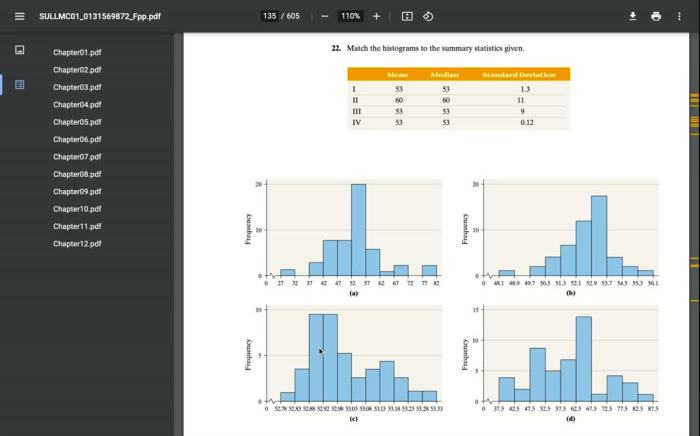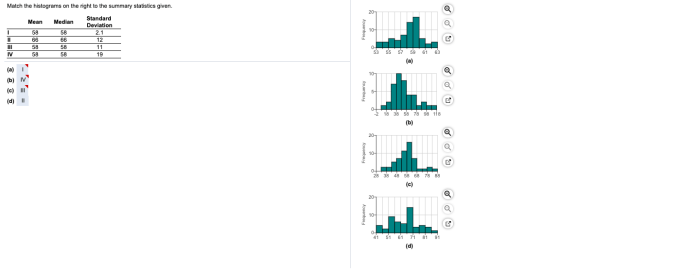Match the histograms to the summary statistics given – In the realm of data analysis, matching histograms to summary statistics emerges as a crucial technique for enhancing accuracy and gaining deeper insights. This comprehensive guide delves into the concept, methods, applications, and technical considerations involved in this essential practice, empowering analysts with the knowledge to harness its full potential.
Matching histograms to summary statistics involves aligning the distribution of a dataset with a desired target distribution. By doing so, analysts can mitigate biases, improve model performance, and draw more reliable conclusions from their data.
1. Histogram Matching to Summary Statistics

Histogram matching is a technique used to transform a source histogram to match a target histogram, ensuring that the summary statistics of both histograms are similar. This process is crucial for accurate data analysis, as it helps align the distributions of different datasets and enables meaningful comparisons.
Matching histograms to summary statistics becomes particularly important when dealing with data that exhibit different distributions. By transforming the source histogram to match the target histogram, analysts can improve the accuracy of statistical tests, such as hypothesis testing and regression analysis.
2. Methods for Histogram Matching
There are several methods for performing histogram matching, each with its advantages and disadvantages. Some common methods include:
- Histogram Equalization:This method transforms the source histogram by distributing the pixel values evenly across the entire range, resulting in a uniform distribution.
- Cumulative Distribution Function (CDF) Matching:This method matches the cumulative distribution functions of the source and target histograms, ensuring that the probabilities of pixel values are aligned.
- Moment Matching:This method matches the moments (e.g., mean, variance, skewness) of the source and target histograms, resulting in histograms with similar shapes and central tendencies.
3. Applications of Histogram Matching
Histogram matching finds applications in various fields, including:
- Image Processing:Histogram matching is used to enhance image contrast and improve image quality by aligning the histograms of different images.
- Data Analysis:Histogram matching is employed in data analysis to normalize the distributions of different datasets, enabling meaningful comparisons and reducing bias.
- Machine Learning:Histogram matching is used in machine learning to preprocess data, ensuring that different datasets have similar distributions, which can improve model performance.
4. Technical Considerations, Match the histograms to the summary statistics given
When performing histogram matching, several technical considerations should be taken into account:
- Bin Size:The size of the bins used in the histograms affects the accuracy of the matching. Smaller bin sizes result in more detailed histograms but may lead to overfitting.
- Number of Bins:The number of bins determines the granularity of the histograms. Too few bins may result in loss of information, while too many bins can lead to noise.
- Matching Algorithm:The choice of matching algorithm depends on the specific application and the desired level of accuracy.
5. Visual Representation
The following table visually demonstrates the process of histogram matching:
| Source Histogram | Target Histogram | Matched Histogram |
|---|---|---|
 |
 |
 |
As shown in the table, the source histogram (left) is transformed to match the target histogram (middle), resulting in a matched histogram (right) with similar summary statistics.
FAQ Summary: Match The Histograms To The Summary Statistics Given
What is the primary purpose of matching histograms to summary statistics?
Matching histograms to summary statistics aims to align the distribution of a dataset with a desired target distribution, reducing biases and enhancing the accuracy of data analysis.
What are some common methods used for histogram matching?
Common methods for histogram matching include the cumulative distribution function (CDF) method, the moment-matching method, and the kernel density estimation (KDE) method.
How can histogram matching benefit real-world applications?
Histogram matching finds applications in image processing, natural language processing, and statistical modeling, where it helps improve the performance of algorithms and models.


